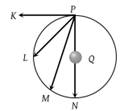Inside a hollow charged spherical conductor, the potential -
(1) Is constant
(2) Varies directly as the distance from the centre
(3) Varies inversely as the distance from the centre
(4) Varies inversely as the square of the distance from the centre
Two charged spheres of radii 10 cm and 15 cm are connected by a thin wire. No current will flow, if they have -
(1) The same charge on each
(2) The same potential
(3) The same energy
(4) The same field on their surfaces
Two spheres A and B of radius 4 cm and 6 cm are given charges of 80 μc and 40μc respectively. If they are connected by a fine wire, the amount of charge flowing from one to the other is -
(1) 20μc from A to B
(2) 16μc from A to B
(3) 32μc from B to A
(4) 32μc from A to B
On rotating a point charge having a charge q around a charge Q in a circle of radius r. The work done will be
(1)
(2)
(3) Zero
(4)
In the figure the charge Q is at the centre of the circle. Work done is maximum when another charge is taken from point P to

(1) K
(2) L
(3) M
(4) N
Two insulated charged conducting spheres of radii 20 cm and 15 cm respectively and having an equal charge of 10 C are connected by a copper wire and then they are separated. Then -
(1) Both the spheres will have the same charge of 10 C
(2) Surface charge density on the 20 cm sphere will be greater than that on the 15 cm sphere
(3) Surface charge density on the 15 cm sphere will be greater than that on the 20 cm sphere
(4) Surface charge density on the two spheres will be equal
Two equal charges q are placed at a distance of 2a and a third charge –2q is placed at the midpoint. The potential energy of the system is -
(1)
(2)
(3)
(4)
How much kinetic energy will be gained by an \(\alpha\text-\text{particle}\) in going from a point at \(70~\text{V}\) to another point at \(50~\text{V}\)?
| 1. | \(40~\text{eV}\) | 2. | \(40~\text{keV}\) |
| 3. | \(40~\text{MeV}\) | 4. | 0 |
If identical charges (–q) are placed at each corner of a cube of side b, then electric potential energy of charge (+q) which is placed at centre of the cube will be -
(1)
(2)
(3)
(4)
Equipotential surfaces associated with an electric field which is increasing in magnitude along the x-direction are
(1) Planes parallel to yz-plane
(2) Planes parallel to xy-plane
(3) Planes parallel to xz-plane
(4) Coaxial cylinders of increasing radii around the x-axis






